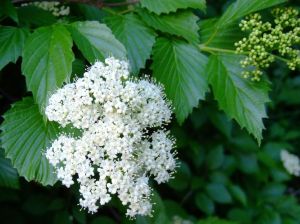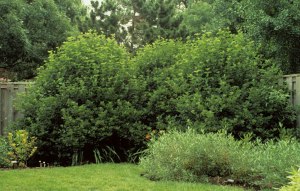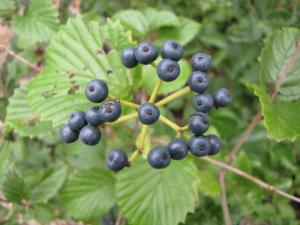
I’ve been bicycling to work on paths that are often separated from the road by a vegetated buffer that is 20 or 30 feet wide. Over the past three weeks I have noticed a flowering shrub with white corymbs and broadly ovate toothed leaves. The habit is a cluster of arched trunks. When the apical bud is broken off other buds along the branch send new branches straight up, giving rise to the common name for this viburnum, arrowwood.
The real name for this shrub is Viburnum dentatum. It is one of several viburnum species distributed through southern New England. This species seems to be especially common in the sandy plains of down-island Martha’s Vineyard. Indeed, at least one of the plant guides notes its preference for coastal areas. It likes well drained soils, but tolerates a wide variety of settings and established plants are somewhat drought tolerant. All these characteristics will help survive the rigors of the central plain of this island, which is so dry that it was never farmed until the advent of drilled wells and large parts of it have never been farmed at all.

As with many easy going shrubs, this one is popular as an ornamental. It suckers like crazy around the base, so it is a good space filler and is planted around parking lots where you want to hide the lot and to prevent users from cutting through where they are not supposed to. The fact that it has attractive blossoms and berries—blue-black drupes—is simply a bonus. It does not need much maintenance although you are advised to prune it after it flowers.
Viburnums (which are part of the Caprifoliaceae family) are part of a small group of woody plants that have leaves that are oppositely arranged. The other common ones are Acer (the maples), Fraxinus (the ashes), Cornus (the dogwoods), Aesculus (the horseschestnuts and buckeyes). People used an acronym as a mnemonic to remember them all: MADCap Horse.

Viburnums have been plagued by the viburnum leaf beetle (Pyrrhalta viburni), which is native to Europe and Asia and was introduced to Ontario, Canada in 1947. It reached Maine in 1994 and soon became a major pest throughout the northeastern U.S. V. dentatum is actually one of the species that is highly susceptible to an attack and a specimen will be killed two or three years into an infestation. There is a boom and bust pattern to the beetle populations. In spite of efforts to save landscape shrubs with sprays and removal of the egg-infested twigs, the beetles reach a point where they have reduced the local populations of viburnums to such low numbers that the larvae begin to starve. In addition, the populations of the natural predators rise along with the beetle populations. Infestations last for a few years and then it is advisable to wait several years before replanting viburnums as ornamentals.
In a 2011 article in the Vineyard Gazette that was about beetle infestations in general, Tom Clark of the Polly Hill Arboretum was quoted thusly: ““When this insect [the viburnum leaf beetle] gets here, it’s more a matter of time than anything else, it’s going to do some serious damage.” In other words, there are a lot of arrowwood viburnums along the bike paths here because the beetle has not yet crossed the seven miles of open sea to get here. In 2004 the state extension service reported that the beetle had crossed the Massachusetts/New York border and was laying waste to the Great Barrington area in the Berkshires. In 2012 the statewide report from the extension was still listing it only as a problem in the Berkshire region and it was a diminishing one.
